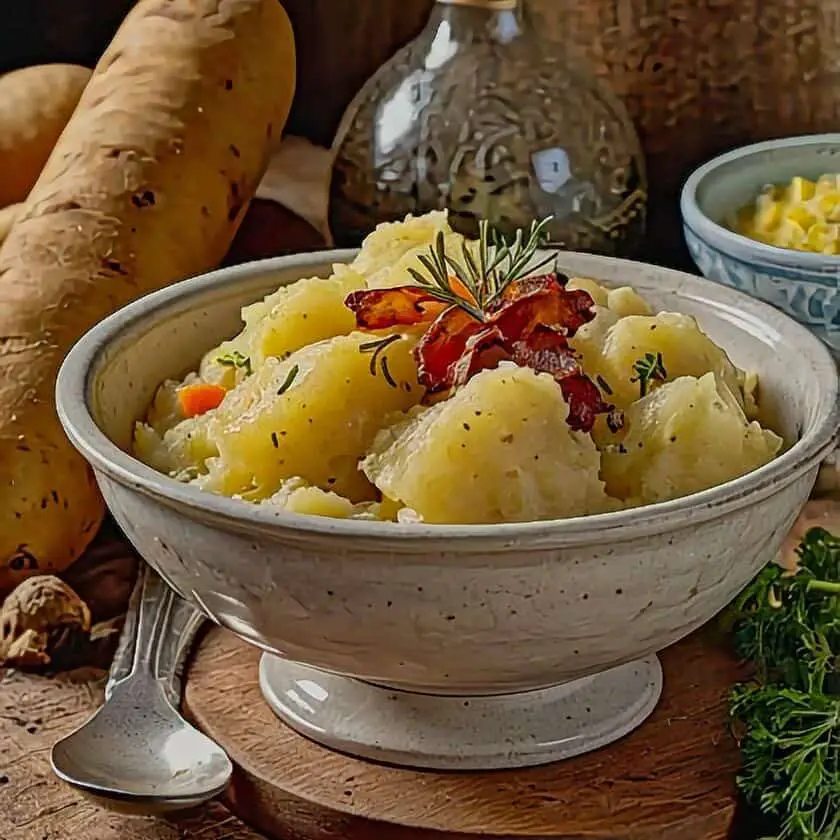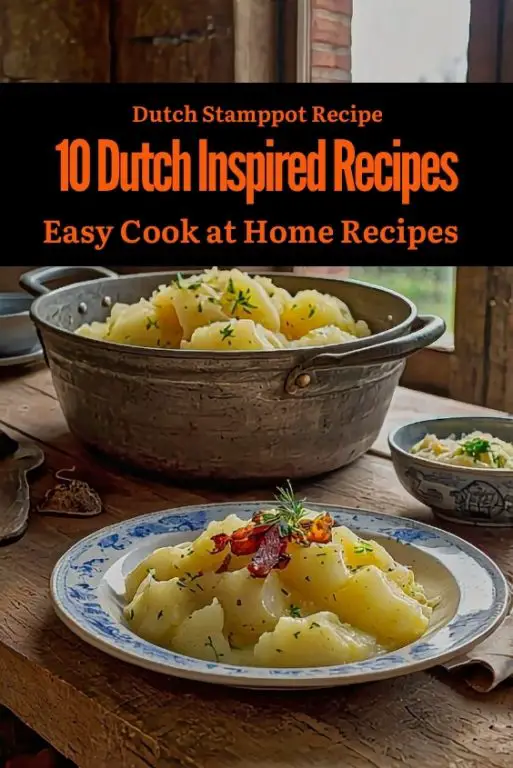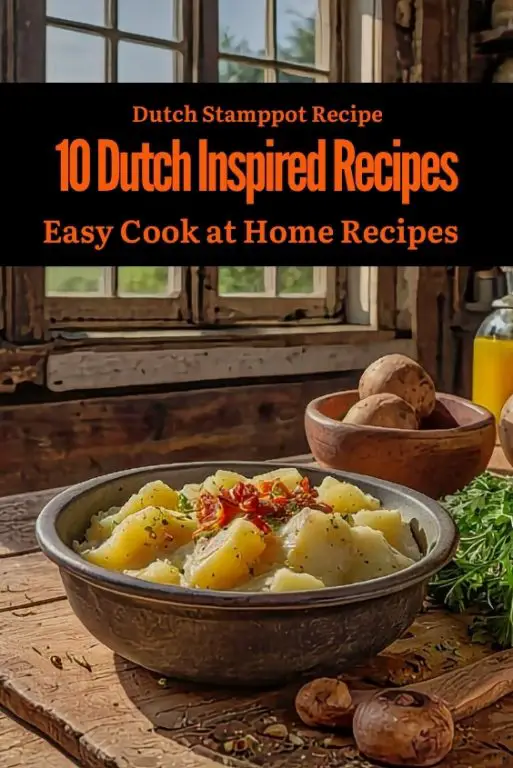The Dutch Stampot Recipe was the dish I learned during a recent homestay in Amsterdam. This dish, traditionally made with potatoes and greens, provided the perfect opportunity to explore the benefits of using fresh ingredients while cooking with the homestay hosts.
The process of making the Dutch Stampot Recipe started with a visit to a nearby market, where fresh ingredients were gathered. The bright green color of kale was really noticeable, and the smell of fresh potatoes was strong in the air. This step showed how important it is to choose good, fresh ingredients, which really improve the final dish.
In the kitchen, the hosts showed how to get the ingredients ready. The potatoes were peeled and chopped carefully, showing how important it is to have them all the same size for cooking evenly. The ingredients were really fresh, and the bright green kale made the dish look colorful and healthy. The hosts described how fresh vegetables enhance the overall taste of the Dutch Stampot Recipe. Using ingredients when they are really fresh makes the taste stronger and more enjoyable.
The next step was to cook the potatoes and kale together until they were soft. This process produced pleasant smells, making the atmosphere feel cozy. The hosts shared their advice on how to make the dish perfectly. For example, they suggested using a potato masher to get a smooth texture while keeping some pieces for added texture. This method makes the dish look better and also gives a nice feeling when you eat it.
After the mash was prepared, adding butter and milk changed it into a rich and creamy treat. The hosts pointed out that using fresh, unsalted butter really changed the flavor of the dish, adding a nice richness that goes well with the greens. The smoked sausage was added later, which made the Dutch Stampot Recipe taste even better and more flavorful.
As everyone got together at the dining table, the bright colors of the food was nice, and the smell was hard to resist. The hosts were happy to share this classic recipe, which has always been an important part of their family. The whole experience showed how important fresh ingredients are for making a meal that you remember. Every ingredient of the Dutch Stampot Recipe added to its filling and warm quality, making it a dish to enjoy with family and friends.
Ingredients For the Dutch Stampot Recipe
Potatoes Peeled and Chopped
Chopped Kale
Sliced Smoked Sausage
Milk
Unsalted Butter
Salt
Pepper
Cooking Instructions For the Dutch Stampot Recipe
- Boil the potatoes in a large pot of salted water for 20-25 minutes, or until tender.
- In a separate pot, blanch the kale for 2-3 minutes until wilted. Drain and set aside.
- In a large skillet, cook the smoked sausage over medium heat until browned on both sides.
- Drain the potatoes and mash them with a potato masher or fork until smooth. Add the kale, milk, butter, and salt and pepper to the mashed potatoes. Stir until well combined. Add the sliced smoked sausage to the potato mixture and stir again.
- Serve hot and enjoy!
5 Essiential Ingredients for Dutch Style Food
Dutch cuisine is known for its simplicity and reliance on fresh, locally sourced ingredients. Whether you’re making hearty winter stews or traditional sweets, certain ingredients are key to capturing the essence of Dutch food. Here are five essential ingredients used in many Dutch-style dishes:
1. Potatoes (Aardappelen)
Potatoes are a staple in Dutch cooking, forming the base of many classic dishes.
The most famous dish featuring potatoes is Stamppot, a traditional meal of mashed potatoes mixed with vegetables like kale (boerenkool) or carrots and onions (hutspot).
Potatoes are also used in patat, the Dutch version of French fries, which are often served with mayonnaise or peanut sauce.
You’ll also find them in erwtensoep, a thick pea soup served with chunks of potato and sausage.
2. Herring (Haring)
Herring, a type of oily fish, plays an important role in Dutch cuisine, especially as a popular street food.
The most traditional way to enjoy herring is raw, typically with chopped onions and pickles. Locals often eat it by holding the fish by the tail and sliding it into their mouths.
Herring is also served on a sandwich, called a broodje haring, often with the same onions and pickles.
It’s available year-round but is especially celebrated in spring during Vlaggetjesdag (Flag Day), which marks the beginning of the herring season.
3. Cheese (Kaas)
The Netherlands is world-renowned for its cheeses, with Gouda and Edam being the most popular.
Cheese is a key part of the Dutch diet, often eaten with bread for breakfast or lunch. It’s also
featured in snacks like kaasstengels (cheese sticks) and kaassoufflé (deep-fried cheese pastry).
Dutch cheese is known for its smooth texture and mild flavor, although aged varieties can have a stronger, more complex taste.
In addition to Gouda and Edam, cheeses like Leiden and Maasdam are also widely used in various dishes or as stand-alone snacks.
4. Butter (Boter)
Butter is a central ingredient in Dutch cooking, especially in baked goods and desserts.
Traditional Dutch pancakes, or pannenkoeken, are fried in butter to give them a rich flavor. Butter is also used in poffertjes, small fluffy pancakes served with powdered sugar.
In many Dutch households, butter is spread thickly on bread, often topped with cheese, chocolate sprinkles (hagelslag), or jam.
Dutch butter is creamy and slightly salty, adding richness to both savory and sweet recipes.
5. Speculaas Spices (Speculaaskruiden)
A blend of warm spices, speculaaskruiden is essential in creating the flavors of Dutch baked goods, particularly around the holidays.
The spice mix typically includes cinnamon, nutmeg, cloves, ginger, cardamom, and white pepper.
Speculaas, a spiced shortcrust biscuit, is a popular Dutch treat, especially during Sinterklaas, a Dutch holiday celebrated in December.
These spices are also used in recipes for gevulde speculaas (filled spice cake), pepernoten (spiced cookies), and other Dutch pastries.
Dutch cuisine is simple yet satisfying, and its unique flavors stem from the combination of these essential ingredients. Potatoes provide the base for hearty meals, herring brings a taste of the sea, and Dutch cheese adds richness to daily snacks and dishes. Butter enhances both savory and sweet treats, while speculaas spices bring warmth and tradition to festive baked goods. Incorporating these ingredients is key to mastering Dutch-style cooking.
Most Popular Spices For Dutch Cooking
Dutch cooking, while known for its simplicity, relies on a few key spices that enhance the flavour of traditional dishes. These spices bring warmth, depth, and character to many classic recipes.
Cinnamon is one of the most commonly used spices in Dutch cuisine, particularly in baked goods. It’s a key ingredient in treats like speculaas and stroopwafels, giving them a sweet and aromatic flavour. Dutch households also use cinnamon in apple pies and stewed fruits.
Nutmeg, which has long been a favourite in Dutch kitchens. Nutmeg is often added to mashed potatoes, vegetables like Brussels sprouts, and even traditional meat dishes such as gehaktballen (Dutch meatballs). Its earthy warmth complements the simple ingredients of many Dutch meals.
Cloves are another essential spice, especially in holiday baking. They’re a key component of the speculaaskruiden spice mix used in festive treats like spiced biscuits and gingerbread. Cloves also enhance savoury dishes, such as pickled vegetables and certain stews, providing a strong, aromatic touch.
Mace, which comes from the same plant as nutmeg, is also widely used. This spice is popular in Dutch pastries and sweets, adding a subtle, slightly spicier note compared to nutmeg. It’s also used in rookworst, the smoked sausage often served with stampot.
Finally, pepper (both black and white) is a staple in many Dutch savoury dishes. Dutch cooks often season meat, stews, and soups with black pepper, while white pepper is typically used in mashed potatoes and creamy sauces for a milder heat.
These spices form the foundation of Dutch cooking, infusing both sweet and savoury dishes with distinct, warming flavours.
 FAQ For the Dutch Stampot Recipe
FAQ For the Dutch Stampot Recipe
Q: What is the origin of the Dutch Stampot recipe?
A: The Dutch Stampot recipe has its roots in traditional Dutch cuisine, where it has been enjoyed for centuries as a comforting and hearty dish. Originating from rural areas, it was a practical way to use up leftover vegetables and potatoes, creating a filling meal for families. This recipe typically includes mashed potatoes mixed with various vegetables, such as kale, carrots, or sauerkraut, making it versatile and adaptable to different tastes. The Dutch Stampot recipe reflects the resourcefulness of Dutch cooks, turning simple ingredients into a beloved staple that continues to be cherished today.
Q: What variations of the Dutch Stampot recipe can I try?
A: There are numerous variations of the Dutch Stampot recipe, allowing you to customize it based on seasonal ingredients or personal preferences. Common adaptations include Stampot boerenkool, which uses curly kale, and Stampot hutspot, featuring carrots and onions. You can also experiment with different types of potatoes or incorporate additional ingredients such as smoked sausage, bacon, or vegetarian options like tempeh for a unique twist. These variations highlight the flexibility of the Dutch Stampot recipe, making it suitable for both traditional and modern dietary needs.
Q: How do I make the Dutch Stampot recipe more flavorful?
A: To enhance the flavor of the Dutch Stampot recipe, start with high-quality ingredients, especially when it comes to the potatoes and vegetables. Consider adding aromatics like garlic or onions during the cooking process, which can deepen the overall taste. You can also incorporate herbs and spices, such as nutmeg or parsley, for an extra layer of flavor. Finally, don’t forget to season generously with salt and pepper to bring out the natural flavors of the ingredients in your Dutch Stampot recipe.
Q: Can the Dutch Stampot recipe be made in advance and frozen?
A: Yes, the Dutch Stampot recipe can be made in advance and is an excellent option for meal prep. After preparing the dish, allow it to cool completely before transferring it to an airtight container. It can be stored in the refrigerator for up to three days or frozen for up to three months. When reheating, simply add a splash of milk or broth to restore the creamy texture, making it easy to enjoy this comforting dish anytime.
Q: What is traditionally served with the Dutch Stampot recipe?
A: Traditionally, the Dutch Stampot recipe is served with a variety of accompaniments that complement its flavors and textures. A popular choice is rookworst, a Dutch smoked sausage, which adds a savory element to the meal. Additionally, some enjoy it with gravy or a rich sauce to drizzle over the top. To round out the meal, consider serving a side of pickles or a simple green salad, providing a refreshing contrast to the hearty Stampot, ensuring a well-balanced dining experience.

Dutch Stamppot
Ingredients
- 2 pounds potatoes, peeled and chopped
- 1 pound kale, stems removed and chopped
- 1 pound smoked sausage, sliced
- 1 cup milk
- ½ cup unsalted butter
- Salt and pepper to taste
Equipment
- Large pot for boiling potatoes
- Another pot for blanching kale
- Large skillet for cooking smoked sausage
- Potato masher or fork
- Measuring cups and spoons
Instructions
- Boil the potatoes in a large pot of salted water for 20-25 minutes, or until tender.
- In a separate pot, blanch the kale for 2-3 minutes until wilted. Drain and set aside.
- In a large skillet, cook the smoked sausage over medium heat until browned on both sides.
- Drain the potatoes and mash them with a potato masher or fork until smooth.
- Add the kale, milk, butter, and salt and pepper to the mashed potatoes. Stir until well combined.
- Add the sliced smoked sausage to the potato mixture and stir again.
- Serve hot and enjoy!




3 comments
The Dutch stamppot recipe was pure comfort in a bowl! The combination of mashed potatoes and sautéed vegetables made for a hearty and filling dish. I added smoked sausage on the side, and it complemented the dish perfectly.
Who knew potatoes could be so versatile? I think adding bacon to the Dutch Stampot recipe would take it to the next level. What do you guys think? Bacon or no bacon?
I cant believe they didnt mention the secret ingredient for the Dutch Stampot recipe – apple syrup! It takes the flavors to a whole new level. Trust me, once you try it, youll never go back!